TAKUDZWA HILLARY CHIWANZA
Zimbabwe is facing a serious crisis of drug and alcohol abuse among its adolescents and young people, according to a recent UNICEF research brief.
 |
| Crisis ... UNICEF reports that Zimbabwe's adolescents among drug abuse victims |
The report, titled “Understanding drug use and substance abuse by Zimbabwean adolescents and young people,” reveals that local drug dealers, known as ‘maJazzman,’ are exploiting the vulnerability of this age group and selling them drugs without any regard for their age or health.
The report, which was compiled by Muthengo Development Studies (MDS), Zimbabwe Civil Liberties and Drug Network (ZCLDN), and Youth Advocates Zimbabwe (YAZ), exposes the alarming locations where drug consumption takes place.
Nearly half of the drug users, 46%, reported using drugs at the dealers’ homes or places of operation, where they are exposed to various risks and dangers.
Another 32% said they used drugs at a friend’s house, while 9% admitted that drug dealers are well-known in their communities and sell drugs openly to anyone who approaches them.
The UNICEF research brief identifies several factors that drive drug and alcohol use among Zimbabwean adolescents and young people.
These include the death of parents, poverty, idleness, absent parents, broken homes, inadequate parenting practices, social influence, stress, deviant behavior traits, and experimentation.
The report also highlights the devastating consequences of substance abuse on individuals, families, and society.
These include gang violence, intimate partner violence, gender-based violence, suicide attempts, school dropouts, and expulsion.
According to the report, the cost of the most commonly abused substances and alcohol is around US$2, making them affordable and accessible to many.
Urban areas show higher rates of substance abuse than rural areas due to the lack of community childcare systems and parental care in rural settings.
The report also notes that transit corridors, such as Chipinge, are hotspots for substance abuse due to the availability of various substances.
The research findings reveal the prevalence of specific substances among abusers.
The report shows that skunk, cannabis, illegal alcohol, cough medicines, and liquors approved by the Liquor Traders Association of Zimbabwe (LTAZ) are used by over 50% of substance abusers.
The report also indicates that skunk and cannabis are the most frequently used substances, with 76.5% and 75.1% of users reporting daily consumption within the 30 days preceding the study.
Illegal alcohol and cough medicines followed with 57.3% and 56.0% respectively.
The UNICEF report also sheds light on the age of initiation into substance abuse among Zimbabwean adolescents and young people.
The report shows that substance abuse often begins during adolescence, with the youngest participant in the ZCLDN study being 14 years old and the median age of first drug use being 18 years old. Similarly, the YAZ study found that the youngest substance abuser was 15 years old.
The MDS study further revealed a shocking case of a 10-year-old user, emphasizing the vulnerability of the 10-18 age group.
The UNICEF report underscores the urgent need for comprehensive interventions to address the issue of substance abuse among Zimbabwean adolescents and young people.
The report calls for a multi-sectoral approach that involves government, civil society, community leaders, parents, teachers, health workers, law enforcement agencies, media, and religious organizations.
The report also recommends strengthening prevention strategies, providing treatment and rehabilitation services, enhancing social protection systems, enforcing legal frameworks, and conducting further research on the topic.
Zimbabwe is grappling with a crisis of substance abuse at an unprecedented level. Earlier this year, ZimFactCheck highlighted the scale at which the drug abuse crisis has gripped the country, writing:
"[D]rug rehabilitation centres are full, and unable to cope with rising demand to accommodate new patients. The centres are estimated to be holding or treating about 5 000 people at any time, with tens of thousands others either not coming forward for, or getting any assistance.
Zimbabwe only has a dozen plus “big” institutions providing drug and substance abuse rehabilitation services, largely a reflection of how recent the crisis is for the country."
As regards the source of the drugs, the bulk of the supplies are coming through the country's porous borders. ZimFactCheck reported:
"The drugs are being smuggled into the country from abroad but mostly through Zimbabwe’s land borders with Mozambique and South Africa, which are also facing drug trafficking problems.
Authorities say some small amounts of illicit drugs, concoctions and alcohol are also manufactured in townships in Zimbabwe’s major towns like Harare, Bulawayo, Gweru and Mutare."
The substance abuse crisis in Zimbabwe, according to the latest UNICEF research report, shows that there is an urgent need for concerted efforts to mitigate this malaise—and this demands approaches that are informed with ample nuance and context; approaches that are humane for the users without condemning them to the abyss of shame and crass judgment.



.jpg)


.jpg)










0 Comments